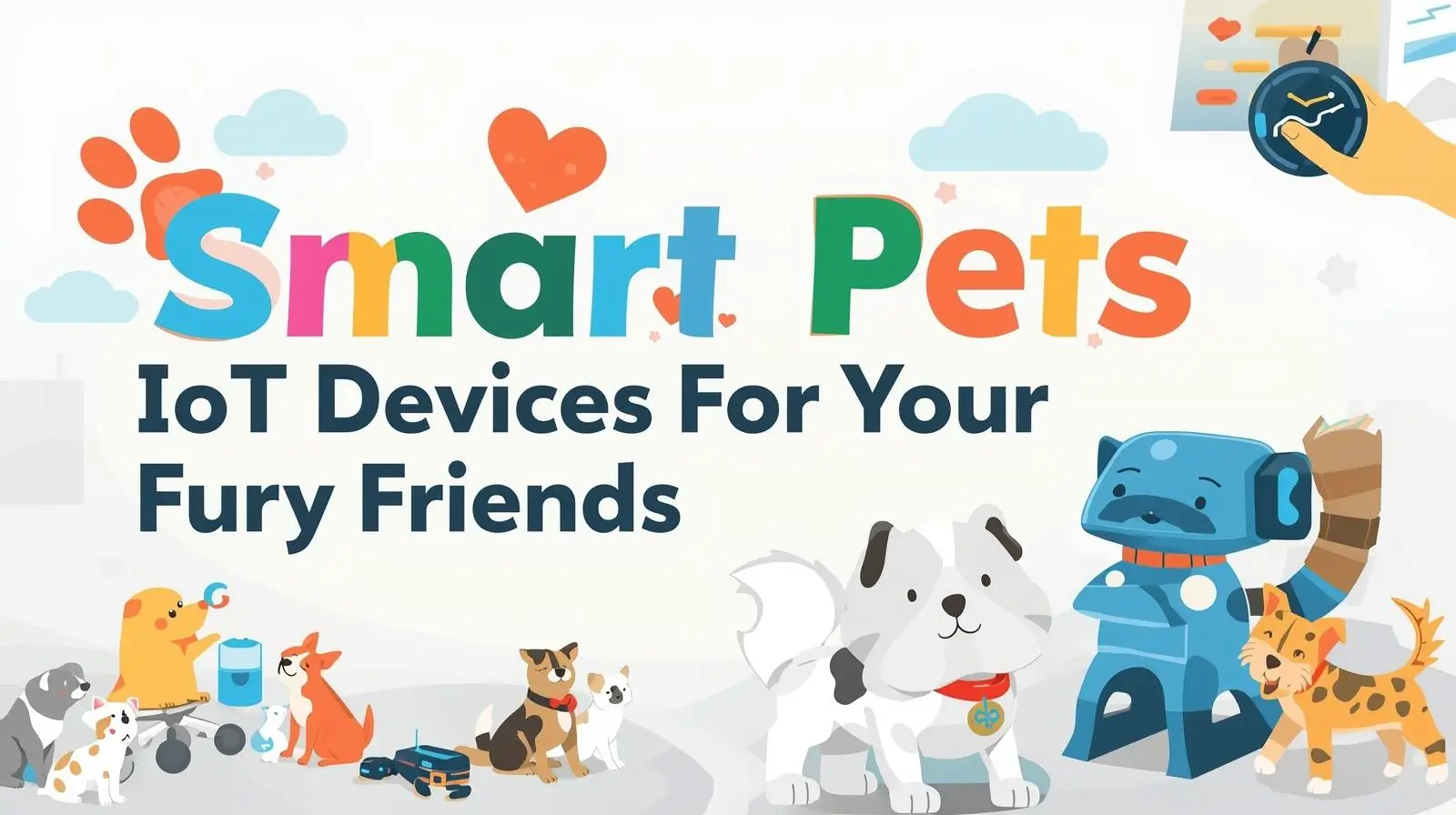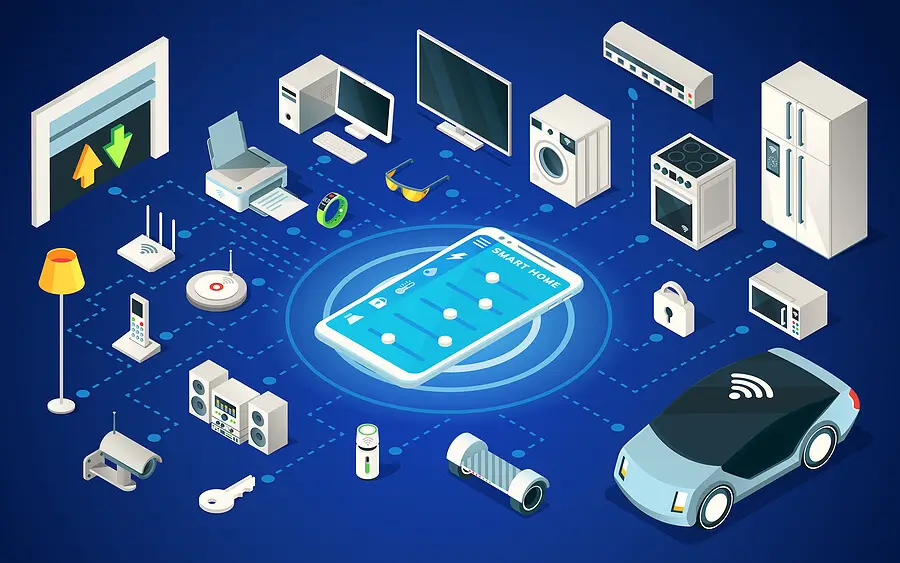Pets are like family members. Just like smart homes make our daily lives easier, smart pet devices using IoT (Internet of Things) are changing how we look after our pets. These gadgets help track health, feed automatically, and keep pets safe. IoT means devices that connect to the internet to collect and share information.
If you're a pet owner, a tech fan, or even building something like an IoT product (such as IoTBeats), this guide explains it all in simple words. We'll cover what these devices do, why they're popular, and more details on each type.
🐾 What Is IoT in Pet Care?
IoT is all about everyday items that connect online to sense things, gather data, and send it to you. For pets, it's simple: these tools help you watch and care for your pet from afar.
Examples include:
- Smart collars that track where your pet is.
- Automatic feeders that give food on a schedule.
- Health trackers that check heart rate or activity.
- Self-cleaning litter boxes for cats.
- Cameras to see your pet live.
- Toys that move on their own.
- Doors that open only for your pet.
- Sensors to monitor the room's air or temperature.
These gadgets let you feed, play with, find, or check on your pet using your phone—even if you're at work or on vacation. They make pet care less stressful and more fun.
🦴 Why Smart Pet IoT Is Growing So Fast
More people own pets now than ever. Busy jobs mean we need help with daily tasks like feeding. We want our pets safe and healthy, and smart homes are common. Companies like Whistle, Fi, Petcube, and Tractive are making cool pet tech. Plus, adding AI (artificial intelligence) helps spot behaviors, send health alerts, and even understand pet emotions.
The pet tech market is booming. It's worth about $12 billion in 2025 and could reach $24 billion by 2030, growing at around 14% each year. Some reports say it might hit $17-60 billion, depending on the source. This growth comes from more pet owners wanting easy ways to care for their animals.
🐶 1. Smart Collars & GPS Trackers
These are super popular because they help find lost pets and watch their health.
What they do:
- Show your pet's location in real time using GPS.
- Count steps, distance walked, and play time.
- Check heart rate and body temperature.
- Send alerts if your pet escapes or gets too hot/cold.
- Set safe zones (geo-fencing) so you get a notification if they leave.
- Use AI to predict behaviors, like if they're stressed.
- Track sleep to spot if something's wrong.
Top picks for 2025:
- Fi Smart Dog Collar Series 3+: Tough and light, great for small dogs too. It has long battery life (up to months) and needs a subscription for full features.
- PetPace 3.0: Focuses on health like breathing and stress. Good for older pets.
- Tractive Dog 6: Affordable, with fast tracking and no range limit.
- Halo Collar 4: Includes virtual fences without wires.
Use cases:
- Stop pets from running away.
- Keep an eye on fitness for active dogs.
- Spot early signs of sickness, like less activity.
- Helpful for service or working dogs.
Pros: Peace of mind, easy app use. Cons: Some need monthly fees ($5-20), and batteries need charging. Tip: Choose waterproof ones if your pet swims.
🍗 2. Smart Feeders (Automatic Feeding Systems)
These make sure your pet eats right, even if you're not home.
Features:
- Set times for meals via an app.
- Control how much food comes out to avoid overeating.
- Alerts when food is low.
- Built-in camera to watch eating.
- Record your voice to call your pet.
- Remote control from anywhere.
- AI adjusts portions based on weight or activity.
Top picks for 2025:
- Petrust PF09: Great for large cats, reliable portions.
- Pifi All-in-One: Works for cats and dogs, with video.
- Cat Mate C500: Simple and no-fuss for cats.
- Petlibro: Custom portions and schedules.
Use cases:
- Help pets lose or maintain weight.
- Feed on time when you're at work.
- Manage meals for multiple pets.
- Good for diabetic pets needing regular eats.
Pros: Saves time, prevents hunger. Cons: Can jam with wet food; clean regularly. Tip: Start with small portions to test.
🧶 3. Smart Toys (Interactive & AI-Driven Play)
Pets get bored alone, so these toys keep them moving and thinking.
Features:
- Toys that roll or chase automatically.
- Control from your phone.
- Drop treats as rewards.
- Laser pointers for cats.
- AI that reacts to your pet's mood (like slowing down if tired).
- Detect if pet is bored or happy.
Top picks for 2025:
- Catstages Tower of Tracks: Simple spinning balls for cats.
- Power Your Fun Robo Pets Robot Dog: Gesture control for fun play.
- Interactive puzzles like Kong Wobble: Hide treats inside.
- Smart balls or lasers from brands like Chelsy's Toys.
Use cases:
- Cut down on chewing furniture from boredom.
- Get lazy pets exercising.
- Build smarter brains through puzzles.
- Keep pets calm when home alone.
Pros: Fun and healthy. Cons: Some need batteries; supervise at first. Tip: Rotate toys to keep interest high.
🏥 4. Smart Health Monitors
Like fitness bands for people, but for pets.
What they track:
- Heart and breathing rates.
- How well they sleep.
- Water drinking amount.
- Daily activity.
- Temperature changes.
- Signs like coughing or scratching.
Advanced ones use cameras and AI to spot:
- Early sickness.
- Behavior problems.
- Allergies or stress.
- Pain levels.
Top picks for 2025:
- PetPace Smart Collar: Real-time vitals and alerts.
- Maven Pet Health Tracker: 24/7 monitoring for heart, activity, and more.
- Whistle Health: Tracks location and health.
- FitBark: Syncs with your phone's fitness app.
Use cases:
- Watch chronic illnesses like arthritis.
- Check recovery after surgery.
- Care for older pets.
- Track weight and exercise.
Pros: Catch problems early. Cons: Data overload; vet check needed. Tip: Pair with apps like Woofz for logs.
🧼 5. Smart Litter Boxes (Automatic Cleaning)
Great for cat owners who hate scooping.
Features:
- Clean waste automatically after use.
- Sensors for waste levels.
- Track urine to spot health issues.
- Control odors with fans or seals.
- App sends cleaning alerts.
Top picks for 2025:
- Litter-Robot 4: Reliable, spacious, and app-connected.
- PetKit PuraMax Pro: Compact with camera.
- CATLINK PRO ULTRA: AI camera for health monitoring.
Use cases:
- Spot kidney problems early from pee changes.
- Keep house clean without effort.
- No daily scooping.
Pros: Saves time, healthier home. Cons: Expensive ($300+); noisy for some cats. Tip: Use clumping litter only.
🎥 6. Smart Cameras for Pets
See and talk to your pet from anywhere.
Features:
- Live video on your phone.
- Speak and hear through two-way audio.
- Throw treats remotely.
- Alerts for motion or barking.
- Daily activity summaries.
- Night vision for dark rooms.
Top picks for 2025:
- TP-Link Tapo C120: Clear picture, pet detection, affordable.
- Furbo 360: Rotates for full view, treat tosser.
- Petcube: Alexa built-in, laser play.
Use cases:
- Check on pets left alone.
- Ease separation anxiety with your voice.
- Train by watching behaviors.
- Extra home security.
Pros: Fun interaction. Cons: Needs good Wi-Fi; privacy concerns. Tip: Place high to avoid pet knocks.
🚪 7. Smart Pet Doors (Controlled Access)
Let your pet in/out safely without you.
Features:
- Opens with RFID on collar (only for your pet).
- Lock/unlock from app.
- Set times, like no night access.
- Detect unwanted animals.
- Log who comes and goes.
Top picks for 2025:
- Pawport: Secure steel, fits existing doors.
- Wayzn Smart Pet Door: For sliding doors, easy install.
- PetSafe SmartDoor: App control, selective entry.
- High Tech Pet: WiFi models for remote open/close.
Use cases:
- Block strays or wildlife.
- Let pets out in the morning automatically.
- Keep inside during storms.
Pros: Freedom for pets. Cons: Battery in collar; install can be tricky. Tip: Measure your pet for right size.
🌡️ 8. Environment Monitoring (Smart Home for Pets)
Make sure the room is comfy and safe.
Features:
- Check temperature and humidity.
- Monitor air quality and CO2.
- Alerts for smoke or bad air.
- Integrate with home vents or AC.
Examples in 2025:
- Many smart collars like PetPace include temp alerts.
- Air purifiers from Gearbrain picks for pet homes.
- Cameras like SiiPet with activity tracking.
- General smart home hubs like Google Nest for pet zones.
Use cases:
- Avoid heatstroke in hot weather.
- Control humidity for breeds like bulldogs.
- Reduce allergies with clean air.
Pros: Safer living space. Cons: Extra cost for sensors. Tip: Link to your smart thermostat.
🤖 9. AI + IoT in Pets (The Future)
AI makes IoT even smarter for pets.
What's coming in 2025 and beyond:
- Recognize pet emotions from barks or movements.
- Predict sickness before you see symptoms.
- Auto-adjust food based on daily needs.
- AI trainers for commands.
- Translators to "understand" pet sounds.
- Pet networks where devices share data.
- Auto-send reports to vets.
- Custom health plans.
Trends: AI diagnostics in vets, behavior apps, and satellite trackers for remote areas. It helps with early detection and personalized care.
💡 10. Business Opportunities in Smart Pet IoT
Want to start something like IoTBeats? Here's ideas for 2025.
Hardware products:
- Smart collars with GPS and health.
- Auto feeders or water bowls.
- Pet cameras with AI.
- Self-cleaning litter boxes.
- Interactive toys.
- Air monitors for pet rooms.
Software ideas:
- Apps for health dashboards.
- AI for behavior insights.
- Geo-fence and location tools.
- Fitness tracking software.
- Auto vet report generators.
The market is hot—pet tech is growing fast with room for new ideas like sustainable gadgets or apps for pet parents. Start small, focus on solving real problems like busy owners or health tracking.




